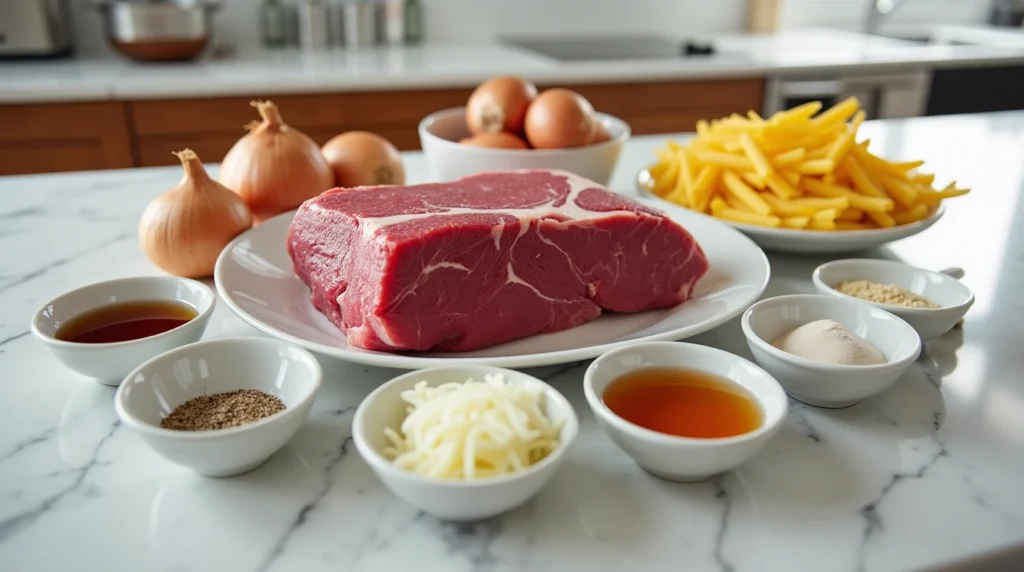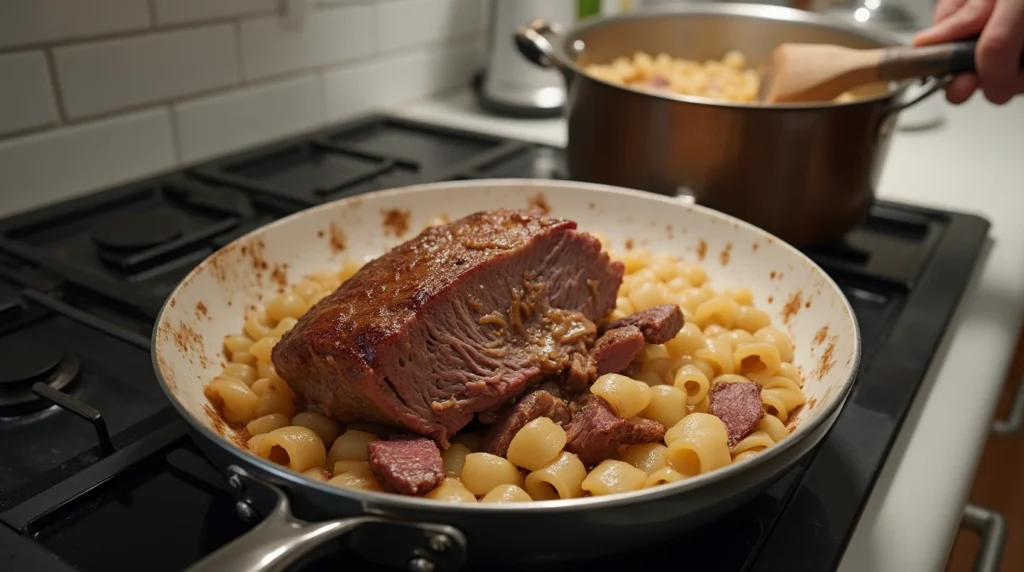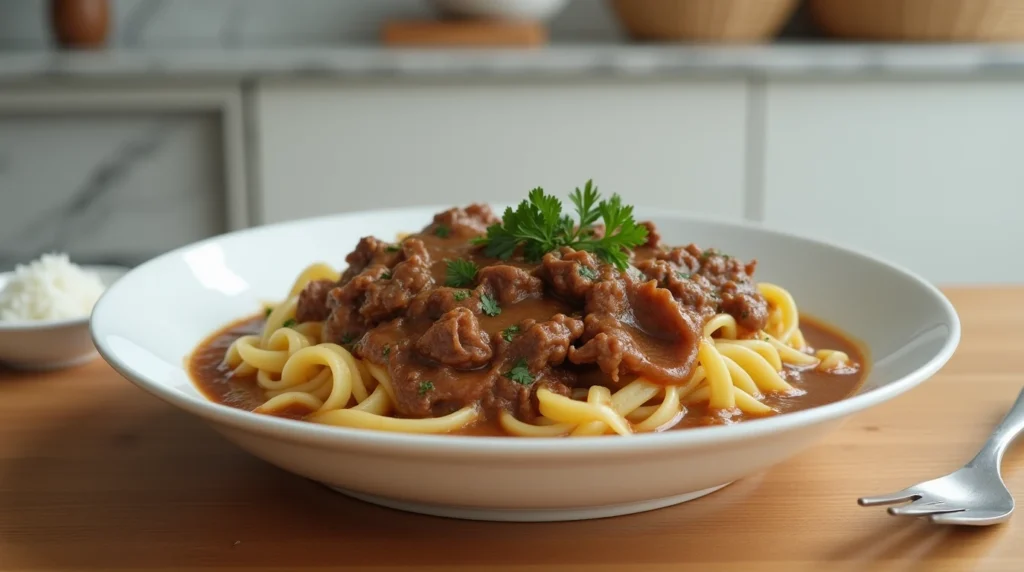Introduction
Let me tell you a secret – I tried recreating this old fashioned beef and noodles recipe seven times before I got it exactly like Grandma’s! The first few attempts were decent, but they were missing that special something that made her version so incredibly comforting. It wasn’t until I called my aunt Martha in Iowa that I discovered the missing ingredient: patience. Grandma never rushed this dish, and neither should we.
Have you ever wondered why some recipes just taste like home? This one does exactly that. Every time I make it, my kitchen fills with the most incredible aroma that reminds me of being eight years old, standing on a step stool next to Grandma’s old gas stove, watching her work her magic. There’s something absolutely magical about tender beef that falls apart at the touch of a fork, swimming in rich, velvety gravy with perfectly chewy egg noodles.
What makes this recipe special isn’t just the incredible flavor – it’s the memories it creates. My kids now ask for “Grandma’s beef and noodles” every time they’re feeling under the weather or need some extra comfort. Trust me, this is the kind of recipe that becomes part of your family’s story.
Table of Contents
Ingredients List

Here’s everything you’ll need for this soul-warming dish. I always keep most of these ingredients on hand because you never know when you’ll need some serious comfort food!
For the Beef:
- 2 pounds beef chuck roast, cut into 2-inch cubes
- 2 tablespoons vegetable oil
- 1 large yellow onion, diced (I get mine from the farmer’s market downtown – they’re so much sweeter than store-bought)
- 3 cloves garlic, minced
- 2 tablespoons all-purpose flour
- 4 cups beef broth (I prefer low-sodium so I can control the salt)
- 2 bay leaves
- 1 teaspoon dried thyme
- 1 teaspoon salt (I use sea salt from my trip to Maine last year – it adds such a clean flavor)
- 1/2 teaspoon black pepper
For the Noodles:
- 12 oz wide egg noodles (the wider, the better – trust me on this!)
- 2 tablespoons butter
- 1/4 cup fresh parsley, chopped
For Thickening:
- 3 tablespoons cornstarch
- 3 tablespoons cold water
Substitution Notes: If you can’t find chuck roast, beef stew meat works wonderfully too. For a lighter version, you can use beef sirloin, though the flavor won’t be quite as rich. I’ve also made this with chicken broth when I was out of beef broth – it’s different but still delicious!
The moment you open that package of beef, you’ll notice how the meat has a deep, rich color. Good chuck roast should have beautiful marbling throughout – those white streaks of fat are what create the incredible tenderness we’re after.
Timing
This recipe requires some patience, but I promise every minute is worth it. Here’s how I typically plan my day around this dish:
Prep Time: 20 minutes Cooking Time: 2 hours 45 minutes Total Time: 3 hours 5 minutes Serves: 6-8 people generously
I usually start this recipe around 1 PM on Sundays, which gives me plenty of time to let the beef get perfectly tender while I catch up on laundry or prep other dishes for the week. The beautiful thing about this recipe is that once you get the beef simmering, it pretty much takes care of itself.
Here’s my Sunday routine: I prep all my vegetables Saturday night after dinner (it only takes 10 minutes), then Sunday after church, I get the beef started. By 4 PM, my house smells absolutely incredible, and we’re sitting down to the most comforting meal you can imagine.
Pro tip from my years of making this: if you’re planning to serve this for a special dinner, start it even earlier. The beef actually tastes better if it has extra time to get incredibly tender – sometimes I’ll let it go for three hours on low heat when I have the time.
Step 1: Preparing the Beef

Pat those beef cubes completely dry with paper towels – this is crucial for getting a good sear. I learned this the hard way during my early cooking days when I’d skip this step and wonder why my beef looked gray instead of beautifully browned.
Heat the vegetable oil in a large Dutch oven or heavy pot over medium-high heat. You’ll know it’s ready when the oil shimmers slightly. Working in batches (don’t overcrowd!), brown the beef cubes on all sides. This should take about 8-10 minutes total per batch.
The first time I made this recipe, I made the mistake of trying to brown all the beef at once. Big mistake! The beef ended up steaming instead of browning, and I missed out on all that incredible flavor that comes from proper searing. Trust me on this – patience here pays off in flavor later.
Step 2: Building the Flavor Base
Remove the beef to a plate and set aside. In the same pot (don’t clean it – all those brown bits are pure gold!), add the diced onion. Cook for about 5 minutes until they start to soften and become translucent.
Add the minced garlic and cook for just 30 seconds until fragrant. Be careful not to let it burn – burned garlic will make the whole dish bitter, and nobody wants that!
Sprinkle the flour over the onions and garlic, stirring constantly for about a minute. This creates what we call a roux, and it’s what’s going to thicken our gravy beautifully.
Step 3: Creating the Perfect Braising Liquid
Slowly pour in the beef broth while whisking constantly to prevent lumps. This is where the magic happens – you’ll see the mixture thicken slightly and take on this gorgeous, rich color.
Add the bay leaves, thyme, salt, and pepper. Return the beef to the pot along with any juices that accumulated on the plate. Bring everything to a gentle boil, then reduce the heat to low.
Cover the pot and let it simmer for 2 to 2.5 hours, stirring occasionally. The beef is ready when it shreds easily with a fork. I usually test a piece after 2 hours – if it’s still a bit tough, I give it another 30 minutes.
Step 4: Cooking the Noodles
About 15 minutes before your beef is done, bring a large pot of salted water to boil. Cook the egg noodles according to package directions until al dente – they should still have a slight bite to them since they’ll continue cooking in the beef mixture.
Drain the noodles and toss them with butter to prevent sticking. I learned this trick from my Italian neighbor – it makes such a difference!
Step 5: Bringing It All Together
Remove the bay leaves from the beef mixture (very important – nobody wants to bite into a bay leaf!). In a small bowl, whisk together the cornstarch and cold water until smooth.
Stir this mixture into the beef and let it simmer for 2-3 minutes until the gravy thickens to your liking. The consistency should coat the back of a spoon nicely.
Add the cooked noodles to the pot and gently fold everything together. Let it sit for 5 minutes off the heat – this allows the noodles to absorb some of that incredible flavor.
Sprinkle with fresh parsley before serving. Trust me, that pop of color and fresh flavor makes all the difference!
Nutritional Information
As someone who’s passionate about balanced nutrition, I always like to know what I’m feeding my family. Here’s the breakdown per serving (based on 6 servings):
- Calories: 485
- Protein: 38g
- Carbohydrates: 42g
- Fat: 18g
- Fiber: 3g
- Sodium: 650mg
- Iron: 4.2mg
This dish is actually quite well-balanced nutritionally. The beef provides high-quality protein and iron, while the noodles give us energy-sustaining carbohydrates. The vegetables add fiber and vitamins, making this a complete meal in one pot.
What I love about this recipe is that it provides substantial nutrition without being heavy. The protein content is excellent for growing kids and active adults, and the iron content is particularly beneficial for women.
Healthier Alternatives for the Recipe
When my daughter went through her “I want to eat healthier” phase in high school, we experimented with several modifications to this classic recipe. Here are the versions that actually worked and still tasted amazing:
Lower-Carb Version: Replace the egg noodles with spiralized zucchini noodles or shiitaki noodles. Add them during the last 2 minutes of cooking so they don’t get mushy.
Gluten-Free Option: Use gluten-free egg noodles (I love the Barilla brand) and substitute the all-purpose flour with cornstarch for thickening.
Lighter Version: Use lean beef sirloin instead of chuck roast and increase the vegetables by adding sliced mushrooms and carrots. The flavor is different but still delicious, and it cuts the calories significantly.
Vegetable-Packed Version: This is my personal favorite modification. I add diced carrots, celery, and mushrooms along with the onions. My kids didn’t even notice the extra vegetables, and it made me feel great about sneaking in more nutrition.
Dairy-Free Option: Simply omit the butter when tossing the noodles, or use a plant-based butter substitute. The dish is naturally dairy-free otherwise.
Serving Suggestions

This dish is incredibly versatile and works for so many occasions. Here are my favorite ways to serve it:
Sunday Family Dinner: I love serving this with a simple green salad dressed with olive oil and lemon, plus some crusty bread for sopping up every drop of that incredible gravy. It’s become our traditional Sunday meal, especially during fall and winter months.
Comfort Food Night: When someone in our family is feeling under the weather or stressed, this is my go-to meal. I serve it in deep bowls with extra parsley and maybe some steamed green beans on the side.
Potluck Perfect: This recipe doubles beautifully and travels well in a slow cooker. I’ve brought it to countless church potlucks and family gatherings – it’s always the first dish to disappear!
Weeknight Simplicity: While it takes time to cook, the hands-off nature makes it perfect for busy weeknights. I start it when I get home from work, and by dinnertime, we have this incredible meal ready.
Holiday Comfort: During stressful holiday seasons, when everyone’s tired of fancy food, this simple, comforting dish is exactly what we all crave.
Instead of wine pairings (which I don’t include in my recipes), I love serving this with sparkling apple cider or homemade lemonade. The slight acidity cuts through the richness beautifully.
Common Mistakes to Avoid
Oh boy, I’ve made every mistake possible with this recipe over the years! Let me save you some trouble by sharing the most common pitfalls:
Rushing the Browning Process: I cannot stress this enough – properly browning the beef is crucial for flavor. Don’t overcrowd the pan, and don’t move the pieces around too much. Let them develop that beautiful brown crust.
Cooking on Too High Heat: The first time I made this, I was impatient and kept the heat too high during the braising process. The result? Tough, chewy beef that never did get tender. Low and slow is the only way to go.
Overcooking the Noodles: Since the noodles will continue to cook when you mix them with the hot beef mixture, slightly undercook them initially. I learned this lesson when I served my family what essentially amounted to beef mush!
Forgetting to Remove Bay Leaves: I’ve done this more times than I care to admit! Always count your bay leaves going in and make sure you remove the same number. Biting into a bay leaf is not pleasant.
Adding Too Much Thickener at Once: When I first started making this recipe, I got impatient with the thickening process and dumped in too much cornstarch mixture at once. The result was an unappetizingly gluey texture. Add it gradually and let it cook for a few minutes before deciding if you need more.
Not Tasting for Seasoning: Always taste and adjust the seasoning before serving. Different brands of broth have varying salt levels, so what worked last time might need adjustment this time.
Storing Tips for the Recipe
This recipe actually improves with time, making it perfect for meal prep! Here’s how I handle leftovers and storage:
Refrigerator Storage: Store leftovers in airtight containers in the refrigerator for up to 4 days. The flavors actually meld and improve overnight – sometimes I think it tastes even better the next day!
Freezing Instructions: This freezes beautifully for up to 3 months. I portion it into family-sized containers and label them with the date. To reheat, thaw overnight in the refrigerator, then reheat gently on the stovetop, adding a splash of broth if needed.
Reheating Tips: When reheating, do it slowly over medium-low heat, stirring occasionally. If the mixture seems too thick, add a little beef broth or water. The noodles will absorb liquid as they sit, so don’t panic if you need to thin it out.
Meal Prep Strategy: On Sundays, I often make a double batch of this recipe. We eat it fresh that night, and I freeze portions for busy weeks ahead. It’s like having a homemade frozen dinner that actually tastes amazing!
Pro Tip: If you know you’ll be freezing portions, slightly undercook the noodles initially. They’ll finish cooking perfectly when you reheat the dish.
FAQs
Over the years, I’ve gotten so many questions about this recipe from friends, family, and blog readers. Here are the most common ones:
Q: Can I use a slow cooker for this recipe?
A: Absolutely! My friend Sarah from Texas makes it this way all the time. Brown the beef and onions first, then transfer everything to your slow cooker. Cook on low for 6-8 hours or high for 3-4 hours. Add the noodles during the last 30 minutes of cooking.
Q: What if I can’t find chuck roast?
A: Beef stew meat works perfectly and is often pre-cut, saving you time. You can also use bottom round roast or even short ribs if you’re feeling fancy. Just adjust the cooking time based on the cut – tougher cuts need longer cooking.
Q: My gravy isn’t thick enough. Help!
A: This happened to me just last month! Make another cornstarch slurry (1 tablespoon cornstarch mixed with 1 tablespoon cold water) and stir it in gradually. Let it simmer for a few minutes between additions until you reach your desired consistency.
Q: Can I add vegetables to this recipe?
A: Of course! My neighbor adds carrots, celery, and mushrooms with the onions. Root vegetables like parsnips or turnips work well too. Just add them early enough in the cooking process to get tender.
Q: Is there a way to make this in advance for entertaining?
A: Yes! Make the beef mixture completely through step 3, then cool and refrigerate for up to 2 days. When ready to serve, reheat the beef mixture, cook fresh noodles, and combine. The flavors are actually better after sitting overnight.
Q: What’s the best type of noodles to use?
A: Wide egg noodles are traditional and my personal favorite, but I’ve also used pappardelle pasta with great results. The key is using something wide enough to hold onto that delicious gravy!
Conclusion
This old fashioned beef and noodles recipe represents everything I love about home cooking – it’s simple, comforting, and brings families together around the dinner table. The tender beef, rich gravy, and perfectly cooked noodles create a meal that satisfies both body and soul. With just a little patience and love, you’ll create a dish that might just become your own family’s Sunday tradition.

